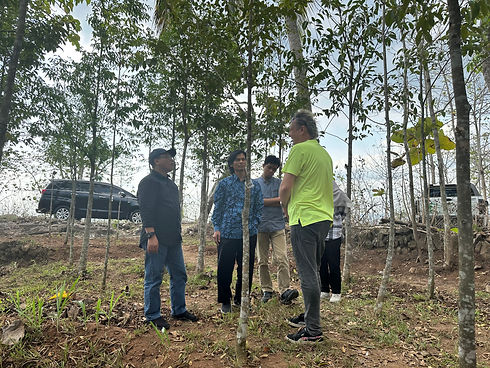Beranda/ Grup / Manajemen Prima


Khynam, Mitos, Volume 1
When contemplating Earth's most rare and valuable substances, your thoughts might instinctively drift to dazzling diamonds, shimmering platinum, or lustrous gold. However, you might be surprised to learn that an extraordinary kind of wood surpasses the value of all these renowned materials.
Enter Khynam, or "Kyara" as it is revered in Japan—an exceptionally scarce and prized form of agarwood. Esteemed in the worlds of perfumery and incense due to its intricately layered and potent aroma, this wood is the epitome of "oud." This term, originating in the Arabian Peninsula, denotes the deep, resin-saturated timber formed within the core of the Aquilaria tree under unique conditions. Astonishingly, a single gram of Khynam can command more than $10,000, making it not only the most costly wood globally but also among the most expensive natural resources on Earth.
Essentially, Khynam represents the pinnacle of agarwood available for purchase, underscoring the fact that all forms of agarwood carry a significant price tag. Known by various names such as aloeswood, eaglewood, or simply oud, agarwood has held a central role in the cultural traditions of Chinese, Japanese, Indian, Arabian, and Southeast Asian societies for millennia. While it has always been a treasured commodity, the recent surge in demand has drastically inflated its market price.
The Aquilaria tree's heartwood begins as relatively odourless and pale, but certain conditions trigger the production of a rich, dark resin that forms the highly valued agarwood. For countless generations, it has been understood that the Aquilaria tree yields agarwood only under duress. While it was once believed that various stressors—such as lightning strikes, insect invasions, or damage from large wildlife—led to this transformation, it ultimately boils down to an infection by a specific mold.
Phialophora parasitica, the mold credited with inciting the development of agarwood, works its magic within the tree's heartwood. This resin-infused wood is renowned for its unmistakable fragrance, employed both as incense and as a base for high-end, luxurious perfumes. Over time, experts have mastered the technique of intentionally inoculating Aquilaria trees with this mold to induce agarwood production. Now, dedicated plantations spanning Asian nations such as Indonesia, Myanmar, and Vietnam focus exclusively on cultivating oud.
It's essential to highlight that while agarwood harvested from plantations is certainly not inexpensive, it falls significantly short of the price commanded by wild agarwood, particularly those specimens of exceptional quality. The rationale lies in the fact that plantation agarwood is typically collected a mere few years post-infection, whereas premium wild agarwood can be hundreds of years old, thus meriting a substantial premium. And among all, no agarwood rivals the expense of Khynam, standing alone as the most treasured of its kind. “Beyond, way beyond the best there is something much rarer that we call Khynam,” agarwood trader Alan Mahaffey told Al Jazeera. “It’s the rarest wood on earth. It’s rarer than titanium, uranium, platinum, rarer than diamond. “It can be $10,000 for one gram. In Shanghai they sold a piece two or three years ago, it was $18m for two kilos of Khynam, so it’s like $9m per kilo.
Mahaffey's most remarkable acquisition of Khynam involved a stunning 16-kilogram piece of 600-year-old wood, a treasure that took an arduous five years to discover. This extraordinary find fetched a jaw-dropping $20 million. Bearing in mind that his interview with Al Jazeera dates back to 2016, it's crucial to note that both the demand and value for premium-quality agarwood have been on a steep incline ever since.
The enigma surrounding Khynam is that there is no definitive method to discern whether an Aquilaria tree currently harbors, or will ever harbor, this precious substance. No expert exists who can identify Khynam without first inhaling the deeply fragrant resin-saturated wood. In most cases, the intricate aroma of Khynam only becomes apparent when a chip of the wood is burned. This extreme rarity and value of wild agarwood have rendered wild Aquilaria trees an increasingly infrequent sight across Asia. The notion that a few grams of the planet's most expensive wood could transform the fortunes of anyone who finds them has drawn many into a relentless and often unrewarding quest. Because the sole method to discover agarwood involves felling and splitting open the tree, these wild specimens are becoming ever more scarce.
The mere hope of acquiring agarwood drives individuals to extraordinary lengths, spending fortunes in the process. Take, for example, the 200-year-old tree within Cambodia’s Wat Bang Kradan temple complex, believed to hold the potential to one day yield Khynam. Japanese buyers famously offered the temple monks an astronomical $23 million for the tree, an offer they steadfastly declined. Today, a military outpost sits close by, its primary mission to vigilantly protect what many regard as the world’s most expensive tree.
As the demand for agarwood continues to soar, a bustling black market has emerged. Yet, even there, Khynam remains an exceptional rarity that commands small fortunes for even the smallest quantities. With the ongoing depletion of ancient wild Aquilaria trees, it seems inevitable that prices will continue their upward trajectory.

